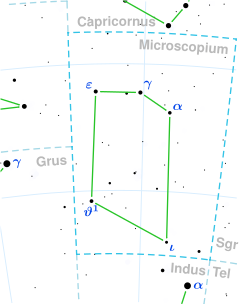| Observation data Epoch J2000.0 Equinox J2000.0 (ICRS) | |
|---|---|
| Constellation | Microscopium [1] |
| Right ascension | 21h 13m 17.32730s [2] |
| Declination | −27° 37′ 09.7106″ [2] |
| Apparent magnitude (V) | 5.39±0.01 [3] |
| Characteristics | |
| Spectral type | K3 III [4] |
| B−V color index | +1.42 [5] |
| Astrometry | |
| Radial velocity (Rv) | −46.2±2.4 [6] km/s |
| Proper motion (μ) | RA: +98.513 mas/yr [2] Dec.: −110.906 mas/yr [2] |
| Parallax (π) | 8.0734±0.1733 mas [2] |
| Distance | 404 ± 9 ly (124 ± 3 pc) |
| Absolute magnitude (MV) | +0.19 [1] |
| Details | |
| Mass | 1.58 [7] M☉ |
| Radius | 31.3±1.6 [8] R☉ |
| Luminosity | 184+9 −8 [2] L☉ |
| Surface gravity (log g) | 1.86 [9] cgs |
| Temperature | 4,225±123 [10] K |
| Metallicity [Fe/H] | −0.17 [9] dex |
| Rotational velocity (v sin i) | <1 [11] km/s |
| Age | 2.59+0.83 −1.90 [2] Gyr |
| Other designations | |
| 3 PsA, 58 G. Microscopii [12] , CD−28°17178, CPD−28°7411, FK5 1556, GC 29652, HD 201901, HIP 104750, HR 8110, SAO 190129 [13] | |
| Database references | |
| SIMBAD | data |
3 Piscis Austrini, also known as HD 201901 or simply 3 PsA, is an astrometric binary [14] (100% chance [15] ) located in the southern constellation Microscopium. It was once part of Piscis Austrinus, the southern fish. The system has a combined apparent magnitude of 5.39, [3] making it faintly visible to the naked eye under ideal conditions. Gaia DR3 parallax measurements imply a distance of 404 light years [2] and it is currently approaching the Solar System with a heliocentric radial velocity of −46.2 km/s . [6] At its current distance, 3 PsA's brightness is diminished by 0.12 magnitudes due to extinction from interstellar dust [16] and it has an absolute magnitude of +0.19. [1]
The visible component is an evolved red giant with a stellar classification of K3 III. [4] The interferometry-measured angular diameter of the star, after correcting for limb darkening, is 2.03±0.04 mas , [17] which, at its estimated distance, equates to a physical radius of about 20 times the radius of the Sun. [18] However, its actual empirical radius is 31.3 R☉. [8] It has 1.58 times the mass of the Sun [7] and is radiating 184 times the luminosity of the Sun [2] from its enlarged photosphere at an effective temperature of 4,225 K . [10] 3 PsA is metal deficient with an iron abundance 68% that of the Sun ([Fe/H] = −0.17) [9] and it spins too slowly for its projected rotational velocity to be measured accurately. [11] It is estimated to be 2.59 billion years old based on Gaia DR3 models. [2]

